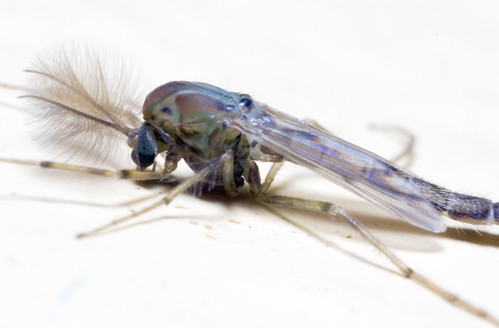
Male adult midge, Sungei Buloh;
(Photo by Marcus)
Then the Lord said to Moses, "Get up early in the morning and confront Pharaoh as he goes to the river and say to him, 'This is what the Lord says: Let my people go, so that they may worship me. If you do not let my people go, I will send swarms of flies on you and your officials, on your people and into your houses. The houses of the Egyptians will be full of flies; even the ground will be covered with them. But on that day I will deal differently with the land of Goshen, where my people live; no swarms of flies will be there, so that you will know that I, the Lord, am in this land. I will make a distinction between my people and your people. This sign will occur tomorrow.'" And the Lord did this. Dense swarms of flies poured into Pharaoh's palace and into the houses of his officials; throughout Egypt the land was ruined by the flies.
- Exodus 8: 20-24

Midge swarm, Utah;
(Photo by AMICHAELMURRAY)
In the previous post, I discussed some aspects of the biology and ecology of the Chironomidae, also known as non-biting midges. I briefly mentioned the tendency of many midge species to form huge swarms, which can have negative effects on human communities in the vicinity. This post will look at one such swarming event in Singapore.

Bedok Reservoir;
(Photo by masact)
With 6 corpses and 2 near-drownings recorded from its waters in recent months, Bedok Reservoir has been appearing quite often in the news, and has gained a particularly gruesome reputation. However, earlier this year, it made the news for a very different reason.
In January, large numbers of midges invaded neighbourhoods around Bedok Reservoir, severely affecting homes and businesses. The swarms continued to plague residents for a few weeks, and cleared up only after fogging and the application of biodegradable insecticides.
In the latest update of Nature in Singapore, my colleagues Lin Yijun and Adam Quek have published a paper on the mass emergence of chironomids in Bedok Reservoir, with some discussion of how people are affected by these massive midge orgies. This paper also represents the first ever documentation of a chironomid mass emergence event in Singapore; such swarms have appeared before, not only at Bedok but also at other reservoirs around Singapore, but information has been mostly anecdotal so far.
The authors visited the Bedok Reservoir area in late January, and managed to collect specimens of adult midges for identification. They were able to identify the species responsible for the swarms as a member of the subfamily Chironominae, but because there are no species identification keys for adult chironomids in Singapore or the entire region for that matter, it was difficult to narrow it down further to the species level.
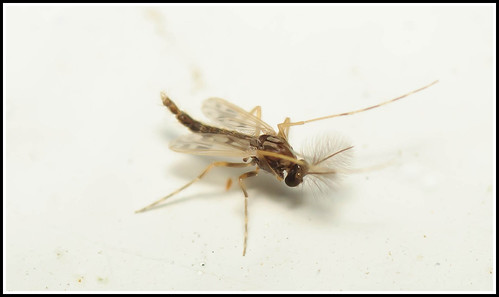
This is one of the midges that was seen at Bedok Reservoir. The feathery antennae indicate that it is a male;
(Photo by zh3nG 正)


Left: Adult male Chironominae collected from Bedok Reservoir, length from tip of antennae to tip of abdomen = 2.4 mm;
Right: Adult female Chironominae collected from Bedok Reservoir, length from tip of antennae to tip of abdomen = 2.54 mm;
(Photos from Lin & Quek, 2011)
Pupal exuviae (cast skins left behind as the adults emerged) were found floating in the water of the reservoir, indicating a high possibility of mass emergence. At the time of observation, a strong wind was blowing predominantly from the north-east which could explain the aggregation of pupal exuviae at the southern and south-eastern shores of the reservoir. Spider webs on the floating pontoons in the reservoir were covered in vast numbers of dead midges. I'm sure the spiders fed very well that month.

Spider web covered in dead midges, Bedok Reservoir;
(Photo from Lin & Quek, 2011)
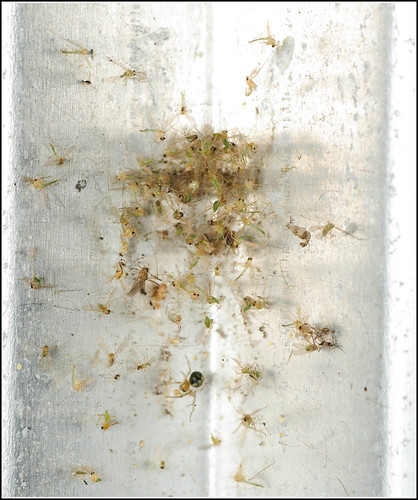
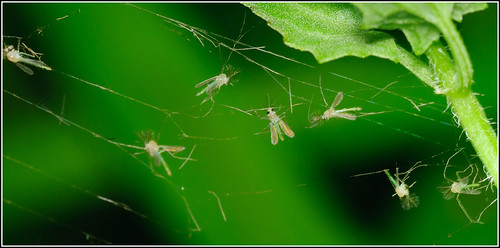
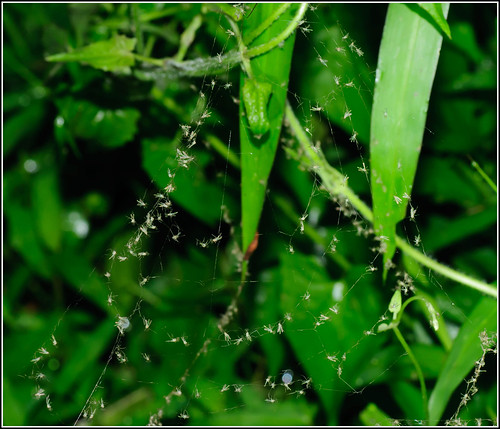

More photos of dead chironomids ensnared in spider webs at Bedok Reservoir;
(Photos by zh3nG 正)
Flocks of small birds, possibly swallows (F. Hirundinidae) and swiftlets (F. Apodidae), were also seen circling in the sky above, presumably feeding on the swarming midges.
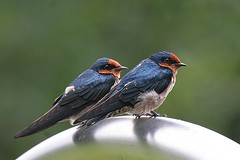
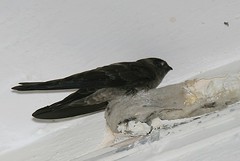
2 common urban birds that would have benefited from the boom in midge numbers.
Left: Pacific swallow (Hirundo tahitica);
Right: Edible-nest swiftlet (Collocalia fuciphaga);
(Photos by kampang)
As stated in the news articles, unsightly accumulations of dead midges were found everywhere.
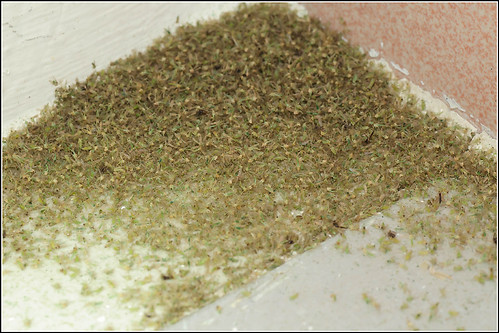
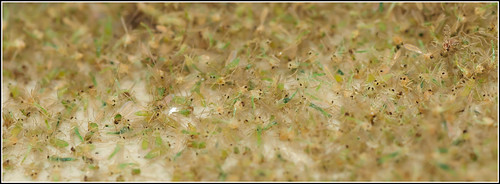
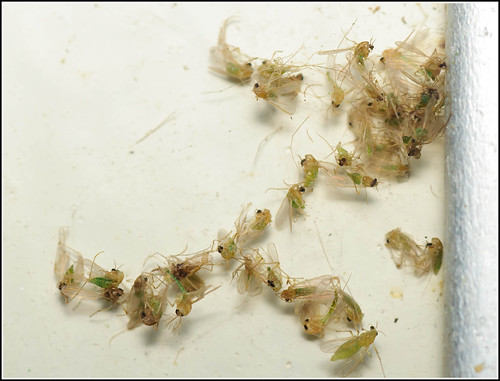

(Photos by zh3nG 正)
What caused the swarms?
Yijun and Adam surmise that this mass emergence of chironomids is a natural phenomenon, albeit one that might have been triggered by some unknown environmental cues. Being able to predict when future swarms are likely to emerge, and taking precautionary measures to reduce the impact on nearby communities, will depend on whether we are able to determine what cues exist to encourage midges to synchronise their emergence and swarm in such terrifying numbers.
One possible cause that Yijun and Adam suggested is the fact that Bedok Reservoir is home to many non-native fish species. Unlike many of our other reservoirs, Bedok Reservoir was created out of a sand quarry in 1981. Hence any fishes within are the result of human introductions. In a study of 15 Singaporean reservoirs, 54 alien fish species were recorded from 14 of the 15 studied reservoirs, and 31 of these non-native species were found to be established and breeding. Perhaps smaller fishes that ordinarily prey on chironomid larvae in Bedok Reservoir suffered a population crash as a result of large predatory fishes being released into the reservoir.
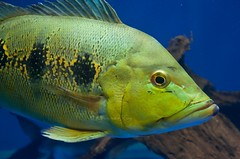

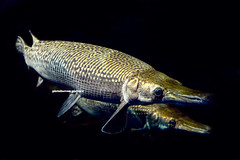
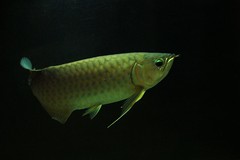
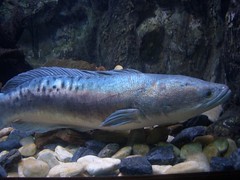

A selection of non-native predatory fishes that have been recorded from Bedok Reservoir.
Top Left: Orinoco peacock bass (Cichla orinocensis) (Photo by xander13);
Top Right: Tucunare peacock bass (Cichla monoculus) (Photo by Pseudotropheus (Drew));
Centre Left: Alligator gar (Atractosteus spatula) (Photo by pistolseven);
Centre Right: Asian arowana (Scleropages formosus) (Photo by captchaos);
Bottom Left: Giant snakehead (Channa micropeltes) (Photo by Fringer);
Bottom Right: African walking catfish (Clarias gariepinus) (Photo by mudiaga);
You can take a look at this Flickr photo set by an angler who regularly goes to Bedok Reservoir, and takes photos of the fishes he manages to land. His sampling method may be skewed more towards catching certain kinds of fish, but it seems like there's a lot of peacock bass in the reservoir.
The presence of all these large predators probably has some impact on the other fish species present in the reservoir, including those that may prey heavily on chironomid larvae. Many of the fish species present in Bedok Reservoir will also presumably feed on aquatic invertebrates, some of which might be predators of chironomid larvae themselves, such as diving beetles and dragonfly nymphs. This removal of other organisms that serve as predators or competitors might then inadvertently lead to a boom in the numbers of chironomids, with more larvae surviving to adulthood. This could create a positive feedback loop, with chironomids eventually becoming so overwhelmingly abundant that the fishes and other predators are simply swamped and are unable to make any real dent in prey numbers, no matter how many larvae they eat.
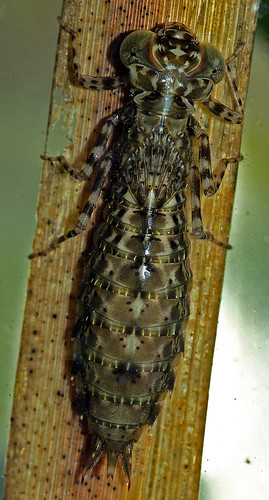
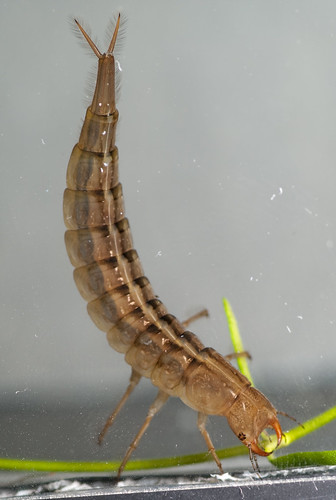
Predatory aquatic invertebrates known to feed on chironomid larvae.
Left: Dragonfly nymph; (Photo by Keith Willits Photo)
Right: Diving beetle larva; (Photo by Neil Phillips)
However, all this is just speculation, since without any real idea of the population trends of the various fish and invertebrate species in the reservoir, there is no way to test this hypothesis. We may never find out which factors helped create the midge swarms of January 2011.
Yijun and Adam note that part of the problem lies with the fact that areas near water bodies are favoured by property developers, to be used for housing or commercial purposes. At the same time, these are areas where chironomids will occur in large numbers and exhibit mass emergence behaviour. Hence, with housing estates sprouting around Bedok Reservoir since its creation in the 1980s, such conflict between people and the midges was bound to occur sooner or later.
Despite the inconveniences and problems that result from mass emergence of midges, it is important to understand the important roles they play in freshwater ecosystems. Not only are they food for a wide variety of animals, both as larvae and as adults, they can also be used as biological indicators in assessments of water quality and for environmental monitoring.
While midge swarms around the world have been controlled largely through the use of chemicals, such as fogging to kill adult midges, and larvicides to control the numbers of larvae, there are other possible strategies. Understanding how physical and chemical parameters in the water may influence chironomid populations across space and time, and then manipulating the environment so as to reduce the number of larvae reaching maturity might prove to be far more effective instead.
The paper ends off by reiterating the fact that we still know so little about chironomids in the region, and so much more needs to be done to understand the ecology, biology, and behaviour of midges.
So while people are wondering if there's something evil lurking in Bedok Reservoir that draws people to die there, I for one am far more concerned about the midges. We're approaching the one year mark since the swarms began. Will the plague of midges become an annual event? Or was it a one-off occurrence, something that happened when all the environmental conditions were perfect? Are other reservoirs in Singapore also at risk of experiencing swarming events on a similar scale, and if so, which neighbourhoods should we warn?
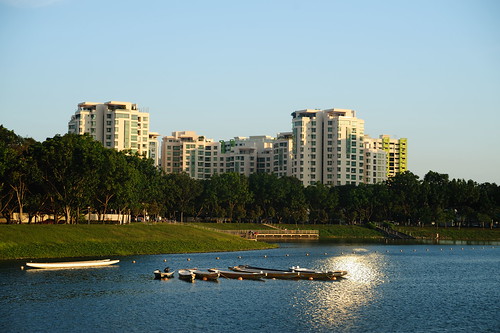
Bedok Reservoir;
(Photo by vinnewage)
There are so many questions waiting to be answered, and right now, we don't quite have the answers yet. Rainforests and coral reefs may get all the attention, but it's about time more people, scientists and laymen alike, took notice of what's going on in tropical freshwater environments.
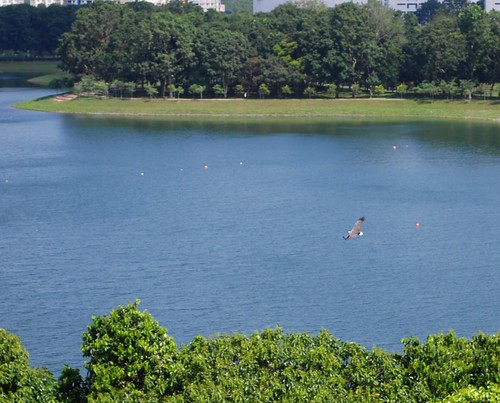
Bedok Reservoir;
(Photo by Fred @ SG)
This is Part 2 of a 2-part series on the Chironomidae, or non-biting midges.
The Chironomids Part I: Marvellous Midges
The Chironomids Part II: Millions of Midges (this post)